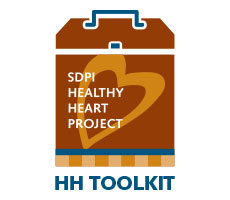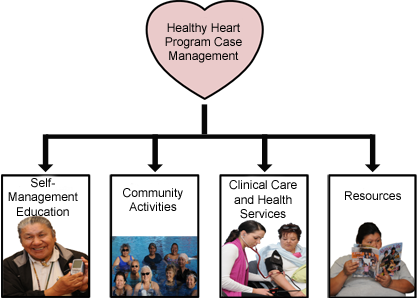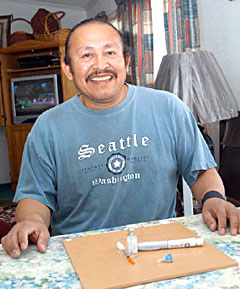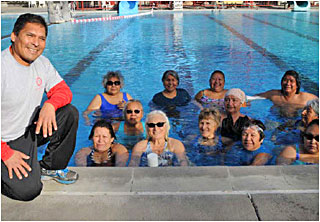Diabetes Healthy Heart Project Toolkit
Archived: This Page Is No Longer Being Updated
This webpage is archived for historical purposes and is no longer being maintained or updated.
Module 3: Implement a Healthy Heart Program
Purpose To provide information on implementing a Healthy Heart (HH) cardiovascular disease risk reduction program using strategies from SDPI HH grantees.
Overview The SDPI HH Program utilized intensive case management services to engage participants in reducing their risk for developing cardiovascular disease (CVD). Case managers worked with participants to develop an individualized care plan and collaborated with the participant's care team to coordinate medical care and medication management. Moreover, case managers provided information and education to help participants make informed decisions about their health and offered participants support as they worked toward achieving their goals. Participants also had the opportunity to join in group education sessions and group activities that focused on lifestyle change behaviors and reinforced the importance of heart health.
The more time we can spend one-on-one, the more trust we build with participants, and the more we can fine tune their health care.

- Module 1: Getting Started
- Module 2: Identifying, Recruiting, and Retaining Participants
- Module 3: Implement a Healthy Heart Program
- Module 4: Build a Sustainable Program
- Appendices
- Acknowledgments
Keys to Success
What is case management?
Case management is the coordination of services and resource referrals that assist in meeting a person's needs for optimal health and wellness. The individual usually has a health condition, such as diabetes, that may require multiple services from multiple providers.
What is a case manager?
A case manager is the primary contact who works collaboratively with individuals and facilitates the coordination of services. Case managers also establish individualized care plans, monitor outcomes, and provide education and support to help participants accomplish their goals.
The case manager closely tracks progress and offers support and guidance in the changes participants choose to make. The relationship that builds between a case manager and a participant is a unique blend of clinician, coach, and supporter. Working consistently with a case manager helps to establish a trusting relationship and minimizes repetition.
A case manager may do all or some of the following:
- Participate as a member of the multi-disciplinary health care team.
- Collaborate with providers to develop evidence-based interventions and action plans.
- Assess participant needs and preferences.
- Make referrals for services including specialty care, food assistance, social services, and self-management education and support.
- Facilitate access to resources (e.g., health insurance, transportation, food).
- Educate and support caregivers.
HH Program Components
Case management is the core component of an HH program. In addition to case management, HH programs may include the following components:
- Self-management Education
- Individual and group education
- Community Activities
- Exercise activities, fun runs/walks, cooking classes, etc.
- Clinical Care and Health Services
- Smoking cessation counseling, labs, pharmacy, primary care provider, specialty care, behavioral health, dental, optometry, and other medical services
- Resources
- Food programs, substance abuse programs, transportation, social services, etc.

- Identify potential services and resources available to participants.
- Clinic services/resources:
- Collaborate with clinic staff and providers to develop a plan for coordinated care.
- Community services/resources:
- Research eligibility criteria and access to local programs and resources, as needed.
- Clinic services/resources:
- Establish policies and procedures to address the following:
- Roles and responsibilities
- Protocols for medication adjustment and ordering lab tests as appropriate
- Licensure will determine whether the case manager can make medication adjustments and/or need to consult with the participant's provider. Consider adapting existing site-specific disease management protocols.
- Case management appointment scheduling
- Coordinate with clinic appointments whenever possible.
- Establish appointment frequency based on the participant's needs and availability.
- Referral process for services, if not provided by the HH program, such as:
- Nutrition education by a registered dietitian, if possible
- Diabetes education by a certified diabetes educator, if possible
- Other professional services (e.g., optometry, dental, podiatry, physical therapy)
- Behavioral health, including substance abuse and smoking cessation
- Social services, benefits coordination
- Access to fitness facility and exercise guidance
- Data collection and evaluation
- Communication protocol when contacting participants (e.g., phone call, letter, text messaging, email)
- Prepare information packets for participants that may include the following:
- Consent forms and waivers
- Program goals
- Program eligibility criteria
- Scope of services related to usual medical care
- Appointment details
- Program contact information
- Calendar of events
For more information and examples of resources to help implement a Healthy Heart Program:
- SDPI HH Program: Module 3: Implement a Healthy Heart Program – Appendix
Enroll Participants
The enrollment visit is usually one of the first interactions that participants have with the HH program team. This is a good time to start building rapport with participants.
- During the enrollment visit:
- Introduce the program and explain how the program is structured.
- Discuss the participant's interest in joining the program.
- Describe the roles of the team, case manager, providers, and the participant.
- Ensure that participants have all consents and waivers signed.
- Those participating in group or individual physical activity should receive medical evaluation and clearance.
Conduct Baseline Assessments
Baseline assessments include a variety of measurable and participant-reported information. Information may be found in the participant's medical record, if available, or may be collected during the enrollment visit. Questionnaires that address health or health behaviors may be used to collect baseline information.
- Collect clinical information, such as:
- Clinical measurements (e.g., weight, height, waist circumference, blood pressure)
- Lab tests (e.g., lipid profile, glycemic levels)
- Medical history
- Medications, prescribed and over the counter (including herbal or other supplements)
- Assess factors that may impact a participant's health and ability to make changes that help reduce CVD risk. This may include:
- Current knowledge of medical condition(s) or health status
- Lifestyle behaviors (e.g., smoking, stress management, physical activity and exercise behaviors, substance use)
- Food insecurity
- Understanding of healthful nutrition (food choices and food preparation)
- Personal and family factors
- Social support
- Education and occupation
- Additional home/family responsibilities that may affect self-management (e.g., primary caregiver)
- Transportation needs
- Resources (financial and emotional)
- If appropriate, estimate CVD risk using a risk calculator (e.g., ASCVD Risk Estimator )
- Document information in the participant's medical record.
For more information and examples of resources to help implement a Healthy Heart Program:
- SDPI HH Program: Module 3: Implement a Healthy Heart Program – Appendix
The individualized care plan identifies treatment interventions and services necessary for improved health outcomes. The case manager collaborates with the participant to develop a personal action plan, set goals, and address any challenges in meeting goals.
- Establish individualized goals with the participant.
- Participants identify their strengths and challenges with the assistance of the case manager.
- Set goals that are specific, measurable, achievable, realistic, and timely.
- Discuss resources and services to help overcome challenges.
- Consider motivational interviewing as a nonjudgmental, non-confrontational method used to engage the participant to talk about their hopes, issues and concerns, and to focus on an issue that they wish to work on.
- Participants identify their strengths and challenges with the assistance of the case manager.
- Work with participants in developing strategies for reducing CVD risk factors.
- Smoking cessation and prevention
- Stress reduction/management
- Improving adherence to medication therapy
- Improving healthy nutrition and access to food
- Increasing physical activity
- Addressing behavioral and mental health issues
- Ensure that the participant understands their individualized care plan as it relates to their medical condition.
- Coordinate services and resources as needed or recommended.
- Self-management education
- Individual and group education
- Community activities
- Exercise activities, food and nutrition activities, etc.
- Clinical care and health services
- Smoking cessation counseling, labs, pharmacy, primary care provider, specialty care, behavioral health, dental, optometry, and other medical services
- Resources
- Food programs, substance abuse programs, transportation, social services, etc.
- Self-management education
- Conduct follow-up visits to monitor progress.
- Review goals with participant.
- Celebrate participant accomplishments.
- Revise goals or targets as appropriate.
- Provide participants frequent updates of their measurements to show their progress.
- Provide routine screening (e.g., tobacco use, depression)
- Review goals with participant.
For more information and examples of resources to help implement a Healthy Heart Program:
- SDPI HH Program: Module 3: Implement a Healthy Heart Program – Appendix
Self-management education is the ongoing delivery of supportive interventions, including education and skills training which increases a participant's confidence to make decisions about managing their health. The participant's care plan outlines the education content recommended to help meet self-management behavioral goals.

Photo of a man sitting at a table with an insulin needle, insulin bottle, and a glucose reader.
- Develop an action plan to implement self-management education.
- Plan includes the educational needs, selection of appropriate content, teaching methods, and interventions to address the participant's plan to reach their goal.
- The goal and action plan are documented in the participant's medical record and communicated with other members of the health care team.
- Select education materials appropriate for the participant.
- Identify appropriate educational methods, materials, and resources to support the learning style of the individual.
- Use audio or visual tools during teaching sessions, as appropriate.
- Consider literacy level, preferred language, and special needs.
- Identify appropriate educational methods, materials, and resources to support the learning style of the individual.
- Consider interactive teaching methods that encourage discussion and promote problem solving, such as:
- Demonstrations which include hands-on activities allow participants to experience the topic being discussed (e.g., food models, using measuring cups/spoons, preparing nutritious meals)
- Teach-back is a method to teach about a topic and then ask that individual to explain back, using their own words, what they heard.
- Offer education in individual and group settings.
- Establish a forum which fosters support and encouragement.
- Identify an appropriate setting for the delivery of education.
- Provide education which progresses from basic to advanced information.
- Considerations for curricula and materials:
- Indian Health Service Division of Diabetes
- National Heart, Lung, and Blood Institute
Note:
As some clinical guidelines may have changed since the publication of materials listed above, ensure that clinical information used is consistent with current guidelines and practices. Refer to the IHS Division of Diabetes Standards of Care and Clinical Practice Recommendations.
For more information and examples of resources to help implement a Healthy Heart Program:
- SDPI HH Program: Module 3: Implement a Healthy Heart Program – Appendix
- Consider alternative settings for visits, education classes, and program activities.
- Home visits by case managers or community health representatives
- Community centers (e.g., senior center, chapter house)
- School or worksite visits
- Enhance participation using different strategies.
- Offer reserved eye and dental appointments.
- Facilitate support groups or talking circles.
- Consider offering men's or women's groups.
- Coordinate book clubs and discussion.
- Consider the audiobook Using Our Wit and Wisdom to Live Well With Diabetes.
- Encourage participation in community activities, such as:
-
Traditional activities and events:

An instructor posing with his water aerobics class.
- Root digging, berry or nut picking, canoe pulling, etc.
- Powwows, feast days, Tribal festivals, etc.
- Educational games and activities (e.g., Healthy Heart Bingo, Healthy Heart Trivia)
- Health fairs
- Fun runs/health walks
- Fitness dance classes
- Walking clubs
- Water aerobics classes
- Food and nutrition activities (e.g., farmers' markets, cooking classes, community gardening)
- Local health awareness events (e.g., heart health summits, family fun days)
-
- Ensure cultural appropriateness and relevance to community.
- Invite or refer the discussion of cultural topics to a recognized elder or community member. Examples of cultural topics to consider:
- Incorporate cultural stories and values.
- Translate the program name, session titles, or the entire curriculum, into the local Tribal language.
- Include terms from the local language (e.g., word for "heart" or certain foods) as part of classes.
- Discuss the traditional use of tobacco.
- Develop strategies for eating more healthfully.
- Focus on traditional foods and prepare them together.
- Provide calorie amounts and recipes for popular local foods (e.g., Heart Healthy American Indian Recipes )
- Incorporate traditional dancing or games into physical activity sessions.
- Invite or refer the discussion of cultural topics to a recognized elder or community member. Examples of cultural topics to consider:
- Recognize participants' accomplishments by promoting success stories and shared experiences (with participants' permission).
- Create success posters.
- Conduct radio interviews.
- Write articles about participant success for local and Tribal newspapers, magazines, blogs, social media, and/or websites.
In an urban setting, it is difficult for many individuals to feel connected. Healthy Heart program participation provides opportunities to belong to a community where participants receive support and education and enables them 'to set goals and take steps to be successful,' as one participant has said.
For more information and examples of resources to help implement a Healthy Heart Program:
- SDPI HH Program: Module 3: Implement a Healthy Heart Program – Appendix
Document Participant Progress
Documenting participant progress will provide meaningful information to guide participant care. A variety of measures can be used to track progress. Assess the capabilities of your program and choose the elements most practical for your situation.
- Establish how often your program will measure progress.
- Tracking measures should start when participants enter the program and at designated intervals thereafter.
- Monitor data on an ongoing basis.
- Assessments, individual care plans, goals, barriers, and education provided
- Attendance for case management visits, classes, events, and activities
- Face to face encounters, phone calls, chart reviews, etc.
- Service utilization (e.g., appointment show rates, hospitalizations, emergency department visits)
- Exam completion rates (e.g., retinopathy, foot, dental)
- Long-term complications
- Microvascular (e.g., retinopathy, kidney disease, foot ulcers)
- Macrovascular (e.g., heart disease, stroke, peripheral vascular disease)
Document HH Program Outcomes
Evaluation is a continuous process that will help to uncover the strengths and weaknesses of your HH program. Program successes can demonstrate the importance and impact of your program to participants, providers, Tribal leaders, administrators, community members, and other stakeholders. Program weaknesses, on the other hand, will demonstrate areas for improvement.
- Use software to compile program data (e.g., Excel, Access, RPMS/EHR)
- Evaluate participant and provider satisfaction with your program
- Consider brief questionnaires, focus groups
- Analyze outcomes data to measure if your program is meeting its goals.
- Examples of outcomes may include:
- Number of show rates for case management appointments
- Program retention rate
- Use outcomes data for planning next steps
- Examples of outcomes may include:
- Consider developing a continuous quality improvement plan for your HH program.
For more information and examples of resources to help implement a Healthy Heart Program:
- SDPI HH Program: Module 3: Implement a Healthy Heart Program – Appendix
Lessons Learned
Case Study: The Healthy Heart PHARM Report
Yakama Indian Health Service Healthy Heart Project
Toppenish, WA
The Yakama Nation Healthy Heart Project used clinically trained pharmacists as case managers to conduct the SDPI HH intensive activities. Pharmacists helped manage medication therapy and were able to build health partnerships with each patient. After implementation of the HH Project, patients received a monthly 30- to 60-minute visit with a pharmacist that focused on diabetes care. "Our patients are learning critical self-management skills and are in better control of their diabetes," said Robin John, Project Coordinator.


